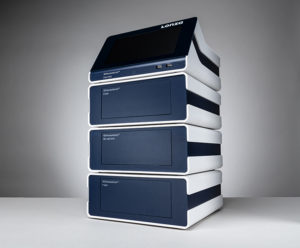 Lonza has launched the next generation of its popular Nucleofector Platform. For more than 20 years, Nucleofector Technology has been an effective non-viral cell transfection method, which can be used even for hard-to-transfect cells, such as primary cells and pluripotent stem cells. Now, with an updated core unit and even more intuitive software, the next generation 4D-Nucleofector Platform delivers flexibility and greater ease of use.
Lonza has launched the next generation of its popular Nucleofector Platform. For more than 20 years, Nucleofector Technology has been an effective non-viral cell transfection method, which can be used even for hard-to-transfect cells, such as primary cells and pluripotent stem cells. Now, with an updated core unit and even more intuitive software, the next generation 4D-Nucleofector Platform delivers flexibility and greater ease of use.
Electroporation, the method by which DNA, RNA or protein is introduced into cells through an electrical pulse to change their genotype or phenotype, is an important tool with a range of applications in disease research and drug discovery, as well as in the advancement of gene therapies, immunotherapies and stem cell generation. The Nucleofector Technology achieves high transfection efficiency in union with high cell viability by providing unique electrical pulses, cell type-specific solutions and optimized protocols to achieve an advanced electroporation approach that targets the cell’s nucleus directly. This powerful combination leads to reproducible, faster, and more efficient results than other methods.
The 4D-Nucleofector Core Unit can operate up to three functional modules, allowing for tailored experimental setups and facilitating scale-up from low to high-volume transfection. In the next generation, the family of units is now joined by a fully integrated 96-well unit to suit users with mid-scale transfection requirements for up to 96 samples at once. In addition, the updated Core Unit features an 8-in. touchscreen display, enabling users to easily set up their experiments and control all functional modules via the system’s intuitive and user-friendly software. Further, optimized protocols are available for more than 750 different cell types and are designed to provide robust transfection conditions, leading to optimal results every time.
The second generation Nucleofector Units include:
- 4D-Nucleofector X Unit – for various cell numbers in 100 µL cuvettes or 20 µL 16-well strips
- 4D-Nucleofector Y Unit – for transfection of cells in adherence in 24-well culture plates
- 4D-Nucleofector LV Unit – for closed, scalable large-volume transfection of up to 1×10⁹ cells
- 4D-Nucleofector 96-well Unit – for simultaneous transfection of up to 96 samples at once
With the Nucleofector System, small-scale protocols can be transferred to a larger scale without the need for re-optimization, bringing together small- and large-scale transfection applications in a single system.
For 20 years, scientists have relied on the Nucleofector Technology to power their research. With the introduction of the next generation 4D-Nucleofector® Platform, users will be able to achieve high transfection efficiencies more easily with the reassurance that their protocols can be effortlessly scaled as needed.
For more information, visit Lonza.com/new-4D-Nucleofector.





Tell Us What You Think!